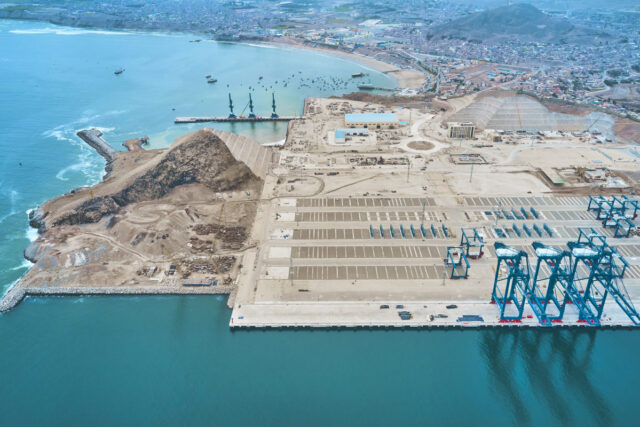Chinese President Xi Jinping and Peruvian President Dina Boluarte officially opened the port of Chancay during a ceremony at Peru’s presidential palace in Lima on Thursday. The development epitomizes Beijing’s ambitions to strengthen trade with South America as the world prepares for more restrictive trade measures under US President-elect Donald Trump.
The port of Chancay, about 70 kilometers north of Lima, is majority owned and operated by China’s Cosco Shipping. The installation promises to reduce cargo travel time between China and Brazil by 10 days – currently it takes 35 days for products to transit from here to our largest trading partner, and vice versa. But significant obstacles threaten to diminish your success.
Simply put, transporting agricultural products from Brazil’s main growing regions to Peru’s west coast requires crossing the sprawling Amazon and crossing the Andes mountains. And yet, there are few good roads and no rail links connecting the regions.
“It’s geographically complicated,” said Marco Germanò, a researcher at New York University who tracks Chinese investments in the region. While the port of Chancay could reignite a long-held dream of integrating South America’s Atlantic and Pacific coasts, he sees no effective plan to bring it to fruition.
Even the connection between Chancay and some coffee and cocoa-producing areas in central Peru is not entirely efficient, said Rafael Zacnich, manager of economic studies at export group ComexPerú. He said he hopes the new port will attract more investors looking to improve infrastructure.
The Chancay port enigma comes as China faces renewed threats of a trade war with the US. The Asian nation was encouraged to find other sources of supply for products such as soybeans and corn, and Brazil, an agricultural powerhouse, is essential. The last time Trump was president, Beijing increased soybean purchases from Brazil as U.S. purchases declined.
READ MORE: How Brazil and Mexico became strategic for Dubai Ports, a partner of Rumo and Suzano
“South America is growing, improving yields, planting more hectares, doing things that need to be done as a country, which puts these volumes on the global stage, and that is absolutely a problem,” said Matt Carstens, CEO of Landus, Iowa’s largest agricultural cooperative. “This port will have an additional effect, not just on what might happen in South America and China, but also in other parts of the world.”
Still, it is unclear how South American governments will address the challenges of geography and poor transportation infrastructure.
“We have to build,” Peruvian Finance Minister José Arista said in an interview. “And building it requires two things: finding out the economic viability and finding out if there is political will to invest the necessary resources.”
Peru is a small economy. Although its exports of copper and other minerals can go to China through Chancay, integration with other South American countries is essential to make the maritime route more relevant.
“The idea is for Peru to be the export hub for Asia,” said Alfredo Thorne, a former finance minister who runs the investment consulting firm Thorne & Associates in Lima. “We have little trade with Brazil, but this could be an opportunity for us to increase.”
The existing highway between the coast of Peru and Brazil’s most prominent agricultural area, in the state of Mato Grosso, requires trucks to cross the Andes. This can be a problem, as the larger trucks that normally transport soybeans and corn are unable to travel on the roads, meaning transport must be done in smaller vehicles.
READ MORE: Mubadala prepares the sale process for Porto Sudeste, says director
“It’s an extremely high cost,” says Edeon Vaz, executive director of Movimento Pro-Logística, which represents soybean and corn producers in the Brazilian state.
Agricultural groups in the small Brazilian state of Acre, which borders Peru, see opportunities emerging at the port of Chancay. Pork and soybean production has increased in the region and transport through Peru will likely happen in the future, according to Assuero Doca Veronez, who heads the Acre Agriculture and Livestock Federation.
“But the logistics infrastructure needs to be set up with better quality,” he stated.
The agribusiness group and local authorities want a new highway connecting the Brazilian city of Cruzeiro do Sul to the Peruvian city of Pucallpa. An attempt to build such a road, however, was halted last year by a federal court due to concerns about potential harm to environmentally protected areas and indigenous communities.
Although the government of Brazilian President Luiz Inácio Lula da Silva wants to improve roads near the border with Peru in the coming years, the construction of a controversial route in Acre is not included in the federal government’s current plan.
The size of the port of Chancay represents a big step for South America, a region that has long suffered from shipping delays – often making products less competitive in foreign markets.
To enjoy such benefits, however, South American countries also need to augment existing transport agreements to allow trucks to flow across borders, said Wagner Cardoso, superintendent of infrastructure at CNI, the National Confederation of Industry.
By Dayanne Sousa and Rachel Gamarski






